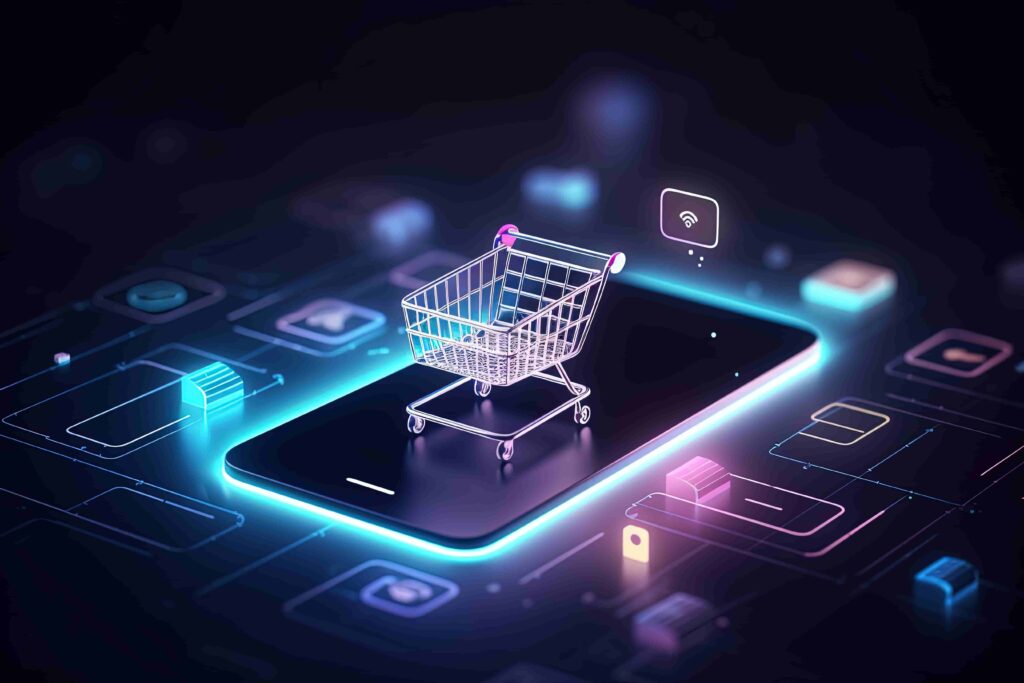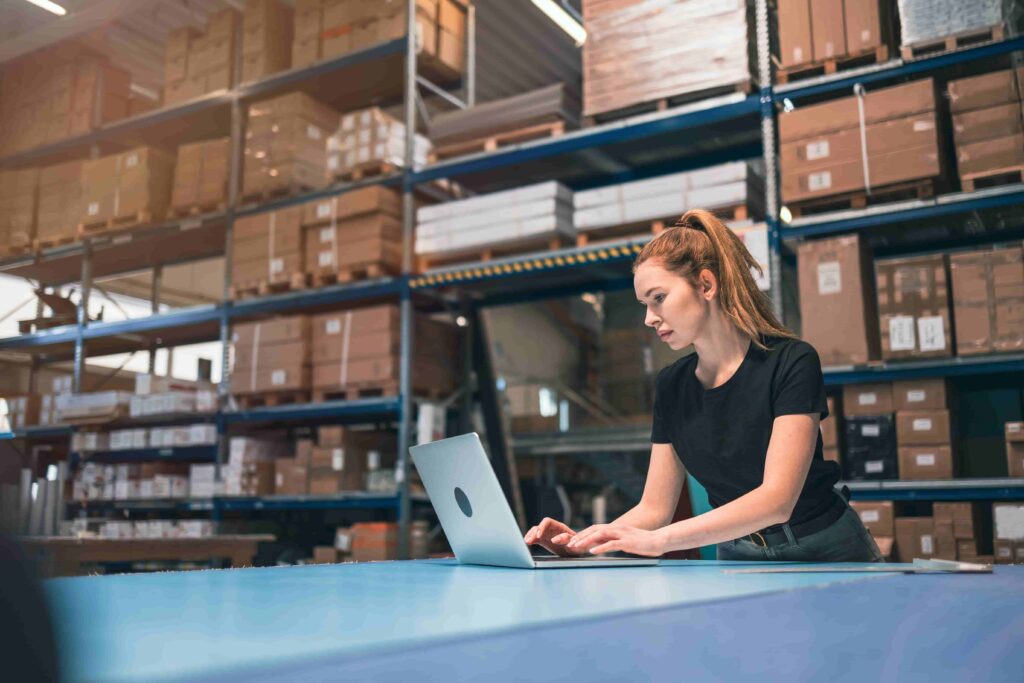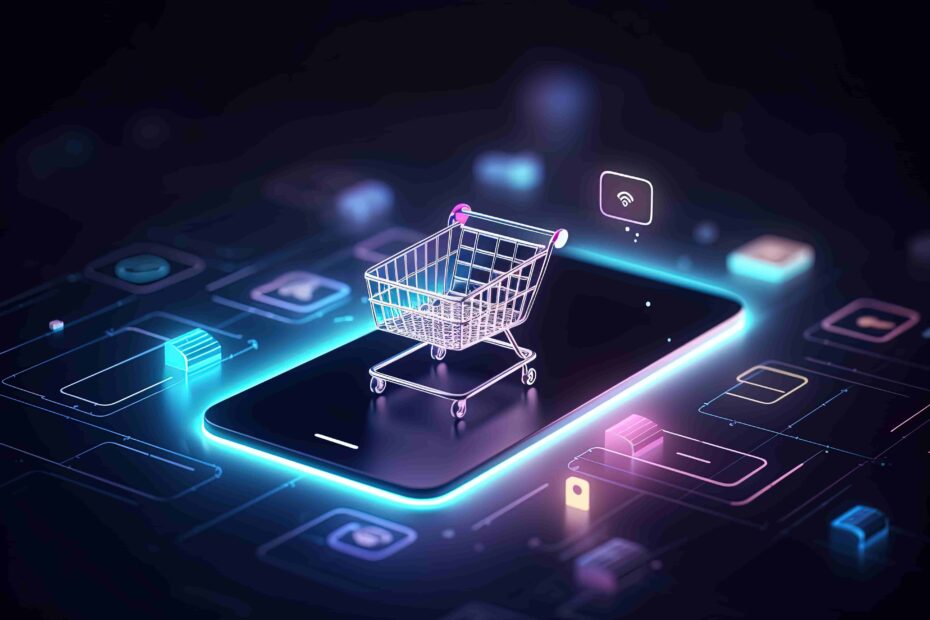Explore how e-commerce transforms shopping

E-commerce has revolutionized the way we consume. Before, we depended on physical stores and their limited opening hours; today, with just one click, we can buy from anywhere, at any time.

Technology and Education
From gamification to blended learning, technology is redefining education. See how schools are adapting to the challenges and opportunities!
This transformation goes beyond convenience. E-commerce integrates technology, innovation and data to offer personalized and interactive experiences.
In this article, we look at how e-commerce is redefining the shopping experience and shaping the future of consumption.
The Evolution of Electronic Commerce
Since its first steps in the 1990s, e-commerce has come a long way, going from being an experimental alternative to traditional retail to becoming the main form of consumption for millions of people.
A Story of Transformation:
E-commerce emerged with the aim of facilitating access to products and services. In 1995, Amazon began its operations selling books, while eBay introduced the concept of online auctions. These first steps marked the beginning of a revolution.
Over the years, the expansion of the internet and the popularization of smartphones have accelerated the growth of the sector. The introduction of secure payment platforms, such as PayPal, and cybersecurity technologies have increased consumer confidence.
The 2020s brought new challenges and opportunities:
- The pandemic has driven the growth of e-commerce in categories previously dominated by physical retail, such as food and essential products.
- Small entrepreneurs have embraced digital as their main strategy to continue operating during periods of social isolation.
Today, e-commerce is more than a convenience. It shapes purchasing behavior, fostering continuous interaction between consumers and brands.
Personalizing the Shopping Experience
In the physical environment, personalization was limited to direct interactions with salespeople. In e-commerce, personalization has taken on another dimension.
By using data, brands can adapt the shopping experience according to each consumer’s individual preferences.
How Personalization Works:
Personalization starts with collecting and analyzing consumer data. Every interaction — from clicks and views to purchases made — provides valuable insights that help brands better understand their customers’ interests and behaviors.
The data collected during navigation allows companies to:
- Understanding Behaviors: Identify what the customer is looking for and offer relevant recommendations.
- Anticipate Needs: Suggest products based on previous purchases or items viewed.
- Customize Offers: Send exclusive discounts or promotions that increase conversion.
Personalization Tools in E-commerce:
- Real-Time Data Analysis: Big data and artificial intelligence tools analyze consumer behavior in real time. For example, if a customer searches for athletic shoes, the system can suggest accessories like socks or gym clothes.
- Cookies and Tracking: Cookies allow websites to track users' actions, offering a continuous and relevant experience throughout the purchasing journey.
- Audience Segmentation: Customers are categorized based on habits, location, age and other factors, enabling personalized offers for each group.
- AI and Machine Learning: Applications and platforms use artificial intelligence to analyze behaviors and adjust recommendations in real time.
- Custom Chatbots: These virtual assistants interact with customers, suggesting products or resolving queries based on their purchase history.
- Segmented Emails: Offers and newsletters are sent according to each customer's profile, increasing the relevance of the content.
Impact: Personalization not only improves the customer experience, but also increases retention and loyalty by creating an emotional connection with the brand.
Advantages of Personalization for Consumers and Businesses

Personalization not only benefits consumers, but also the companies that use it as a strategy.
For Consumers:
- Relevance:
- Receive recommendations for products or services that really interest you.
- Avoid unnecessary information overload.
- Ease of Decision Making:
- Guided navigations reduce the time spent finding desired items.
- Personalized experiences, such as virtual fitting rooms, increase purchasing confidence.
- Exclusive Offers:
- Promotions targeted to specific needs or preferences.
For Companies:
- Increased Conversion:
- Products suggested based on customer behavior are more likely to sell.
- According to studies, personalization can increase conversion rates by up to 30%.
- Customer Loyalty:
- Consumers who feel understood tend to return and recommend the brand to others.
- Strategic Insights:
- Data analysis generates insights into market trends and consumer behavior, helping in planning future campaigns.
Multichannel and Omnichannel Experience
The evolution of consumer behavior, combined with technological advances, has driven brands to create integrated shopping experiences.
Today, consumers interact with companies in a variety of ways — through websites, apps, physical stores or social media — and they expect these interactions to be consistent and fluid.
This is where multichannel and omnichannel strategies come in, which have transformed the way we shop.
What is Multichannel Experience?
In the multichannel model, companies offer different touchpoints for consumers, such as physical stores, e-commerce, apps and social networks. Each channel operates independently, allowing customers to choose the most convenient one.
Multichannel Experience Example:
- The customer can search on the website, check stock on the app and buy directly in the physical store.
- Each channel works in isolation, but complements the customer journey.
Despite being efficient, the multichannel experience often lacks full integration between touchpoints, which can limit the continuity of interaction.

Education Apps: Learn New Skills
Explore the best education apps and discover tools to learn new skills, languages and knowledge in a practical way.
What is Omnichannel Experience?
Omnichannel goes beyond multichannel, connecting all channels seamlessly. This means that the customer can switch between different touchpoints without interruptions or inconsistencies.
Omnichannel Experience Example:
- The consumer starts the purchase on the website, checks the availability of the product in the app and chooses to collect it in the physical store.
- During pickup, a salesperson accesses the customer’s history to offer personalized recommendations.
The omnichannel experience provides continuity and fluidity, creating a more convenient journey aligned with the expectations of the modern consumer.
Benefits of Omnichannel Experience:
- Consistency: Messages and promotions are standardized across all channels, reinforcing brand identity.
- Improved Customer Satisfaction: The customer feels that their experience is personalized and fluid, regardless of the chosen channel.
- Increase in Sales: Studies show that consumers who use multiple channels spend up to 30% more than those who use just one.
- Customer Retention: Continuity in the experience creates a stronger bond between the customer and the brand, increasing loyalty.
Practical Example:
Starbucks is a pioneer in the use of omnichannel strategies. Its app allows customers to order in advance, accumulate points and track exclusive promotions, creating a seamless experience between online and offline.
The Role of Artificial Intelligence in E-commerce
Artificial intelligence (AI) is shaping the future of e-commerce by revolutionizing the way businesses operate and interact with consumers.
With its ability to process large volumes of data and identify complex patterns, AI has become an indispensable tool for personalization, automation and efficiency at every stage of e-commerce.
AI is impacting e-commerce on multiple levels, from the consumer experience to internal operations management. Some areas where artificial intelligence has had a significant impact include:
1. Personalizing Shopping Experiences
- Smart Recommendations: AI algorithms analyze data like purchase history and browsing patterns to suggest highly relevant products.
- Dynamic Content: Websites and apps adapt banners, offers and product displays based on customer profiles.
- Forecast of Needs: AI anticipates behaviors, offering suggestions before the customer even realizes their need.
Practical Example: Amazon uses AI to display a “Recommended Products” section that varies based on each customer’s interests and actions on the site.
2. Customer Service Automation
- Chatbots and Virtual Assistants: Capable of resolving queries, offering support and even finalizing sales, chatbots are a practical and cost-effective solution for 24/7 service.
- Sentiment Analysis: AI tools identify the tone of customer messages, helping to prioritize and personalize support.
- Proactive Resolution: Automated systems detect problems with orders or transactions and offer solutions before the customer even complains.
Example: Sephora's Facebook Messenger chatbot helps customers choose products, offers tutorials, and completes purchases directly in the conversation.
3. Inventory Management and Optimization
AI enables companies to manage inventory more efficiently, reducing costs and optimizing operations:
- Demand Forecast: Algorithms analyze sales history, seasonality and trends to predict future demand.
- Automated Replacement: Systems automatically adjust inventory levels, ensuring popular products are never out of stock.
- Loss Reduction: Identification of products with low turnover, allowing strategies such as promotions to avoid losses.
Impact: Companies that use AI in inventory management report significant reductions in operational costs and increases in logistics efficiency.
4. Advanced Marketing and Segmentation
AI transforms marketing campaigns into highly targeted and effective strategies:
- Custom Ads: Platforms like Google Ads and Facebook Ads use AI to target specific audiences based on demographic and behavioral data.
- Campaign Optimization: Algorithms automatically adjust campaigns to maximize conversions and reduce costs.
- Automated Messages: Tools like Mailchimp send personalized emails based on customer purchasing behavior.
Practical Example: Netflix uses AI to create email marketing campaigns based on users' content preferences, increasing engagement.
Business Impact:
Integrating AI into e-commerce brings significant benefits to businesses and consumers:
For Companies:

- Operational Efficiency: Automated processes reduce costs and optimize time.
- Increase in Sales: Personalized experiences drive conversion and loyalty.
- Real-Time Analysis: Data-driven decisions help you adapt strategies quickly.
For Consumers:
- Enriched Shopping Experience: Relevance and convenience in every interaction.
- Fast Service: Instant solutions to queries and problems.
- Precise Recommendations: Suggestions that make choosing products easier.
Augmented and Virtual Reality
Augmented reality (AR) and virtual reality (VR) are transforming e-commerce, creating immersive experiences that bring consumers closer to products before they even make a purchase.
These technologies reduce barriers, offer interactivity and increase customer confidence, becoming an indispensable trend in the sector.
- Augmented Reality (AR): Integrates virtual elements into the real world through devices such as smartphones or tablets.
- Virtual Reality (VR): It offers a fully immersive experience in a digitally created virtual environment, usually accessed through VR glasses.
Both technologies are applied in different, but complementary, ways in e-commerce.
Transforming the Purchasing Process:
1. Product Simulation
- Virtual Fitting Rooms: With AR, customers can try on clothes, accessories or makeup without leaving their homes.
- Furniture and Decoration View: Tools allow you to virtually insert furniture into real environments, helping you check how it fits together.
Practical Example: IKEA uses AR in its app to let customers visualize furniture and decorations in their homes.
2. Immersive Shopping Experiences
- Virtual Stores in VR: They create environments where customers can explore products as if they were in a physical store.
- Virtual Tours: Consumers virtually visit stores or factories, increasing brand trust.
Example: Dior offers VR experiences that allow customers to explore fashion collections and watch runway shows virtually.
3. Increased Consumer Confidence
The ability to view and try products before purchasing reduces uncertainty, increasing confidence and reducing returns.
Impact: According to studies, the use of AR on e-commerce platforms can increase conversion rates by up to 40%.
Impact of Virtual and Augmented Reality:
These technologies increase consumer confidence in purchasing, especially in categories where appearance or fit are deciding factors.
Practical Example:
Sephora uses AR in its app, allowing customers to test makeup shades in real time. This not only reduces returns but also improves the customer experience.
Fast Deliveries and Advanced Logistics
Speed and efficiency of deliveries are decisive factors in modern e-commerce. Consumers value the convenience of receiving products in increasingly shorter timeframes, which requires constant logistical innovations from companies.

Digital Privacy
Understand how to protect your data, applications and browsing on mobile devices with essential privacy and security practices.
Main Advances in Logistics:
- Same Day Delivery:
Companies like Amazon and Mercado Livre are leading the way with ultra-fast delivery models in large urban centers. This service relies on decentralized warehouses and artificial intelligence to optimize routes. - Warehouse Automation:
Robots and automated systems streamline processes such as product separation and inventory organization, reducing errors and increasing productivity. - Sustainable Delivery:
Electric vehicles and bicycles are increasingly being used to reduce carbon footprint, especially in urban areas.
Challenges and Solutions:
- Remote Regions: Access to remote areas is still a barrier. Companies are investing in local partnerships and solutions such as drones to overcome this challenge.
- Cost Reduction: Advanced logistics requires high investments, but the increase in volume and efficiency pays off in the long term.
Tip: Offer flexible delivery options, such as lockers and pickup points, to meet different customer needs.
Mobile Commerce (M-commerce)
The growth in smartphone usage has made mobile devices the primary platform for online shopping. Mobile-optimized websites and apps ensure that consumers can make purchases quickly and conveniently.
Strategies for M-commerce:
- Mobile-Friendly Websites: Responsive platforms that adjust to the screen size, providing a fluid experience.
- Dedicated Apps: Apps offer unique features like personalized notifications and simplified payment.
- Fast Payments: Integration with digital wallets like Apple Pay and Google Pay allows for one-tap transactions.
Impact of M-commerce:
Data shows that more than 70% of online purchases are made via mobile devices. This trend reinforces the need to prioritize the mobile experience.
Example: The AliExpress app allows consumers to access exclusive and personalized promotions, increasing engagement and sales.
Digital Payments and Online Security
With the expansion of e-commerce, payment methods have evolved to meet consumers' needs for convenience and security.
Innovations in Digital Payments:
- PIX: Popular in Brazil, it allows instant transfers at no cost to customers.
- Digital Wallets: Tools like PayPal, Mercado Pago and PicPay offer speed and convenience.
- Contactless Payment: Increasingly present in both physical stores and e-commerce with compatible devices.
Security Measures:
- Encryption: Protects sensitive data during transactions.
- Two-Factor Authentication: Adds an extra layer of security, ensuring that only the account holder makes purchases.
- SSL Certification: Indicates that the site is secure, increasing consumer confidence.
Tip: Offer multiple payment options to suit different customer preferences, prioritizing secure and intuitive solutions.
Sustainable E-commerce
Sustainability has become an important factor for consumers and businesses alike. Sustainable e-commerce prioritizes environmentally friendly practices throughout the entire chain of operations, from production to delivery.
Sustainable Practices in E-commerce:
- Eco-friendly Packaging: Reducing the use of plastic and adopting recyclable materials are strong trends.
- Green Logistics: Use of electric vehicles or bicycles to reduce emissions.
- Circular Economy: Encourage product return or recycling programs.
Inspiring Example: Patagonia, a clothing brand, promotes the repair and resale of used products, aligning itself with the values of its customers.
Benefit: Companies that adopt sustainable practices not only help the planet, but also win the loyalty of conscious consumers.
Social Commerce: Shopping through Social Networks
Social networks have become dynamic and interactive showcases for brands, making social commerce one of the fastest growing segments in e-commerce.
How it works:
- Instagram Shopping: Tag products in posts and stories, allowing consumers to purchase directly.
- Commercial Lives: Showcase products in real time and answer customer questions.
- Influencer Partnerships: Collaborative campaigns that generate engagement and increase conversions.
Impact of Social Commerce:
Social media not only facilitates shopping, but also promotes a sense of community between brands and consumers, strengthening relationships.
Trend: Platforms like TikTok are investing in social commerce features, expanding the possibilities for brands to reach new audiences.
Global Access to Consumption

E-commerce has eliminated borders, allowing consumers to purchase products from anywhere in the world. This connectivity offers access to unique items and new opportunities for businesses large and small.
How E-commerce Connects Markets:
- Global Platforms: Sites like Amazon, eBay and AliExpress offer products from different countries.
- Translation Tools: With the use of AI, e-commerces offer automatic translations, making the experience more inclusive.
- International Logistics Partnerships: Companies integrate shipping services to reduce shipping times and costs.
Challenges of International Trade:
- Taxes and Customs: Additional costs may impact the final price.
- Delivery Times: International orders still face time challenges in remote regions.
- Local Regulations: Products must comply with the rules of the destination country.
Opportunities for Local Businesses:
Small businesses can access global markets through international marketplaces and targeted digital marketing strategies.
Example: Brazilian artisans use Etsy to sell authentic and cultural products to international customers.
Future of E-Commerce
E-commerce is constantly evolving, with new technologies emerging to make the shopping experience even more efficient and immersive.
Long-Term Trends:
- Metaverse:
- Shopping experiences in virtual environments, such as immersive stores.
- Social interactions with avatars of other consumers or sellers.
- Blockchain:
- Transparency and security in financial transactions and supply chains.
- Use of cryptocurrencies as a form of payment.
- IoT (Internet of Things):
- Connected appliances that make purchases automatically, such as a refrigerator that restocks essential items.
- Voice and Virtual Assistants:
- Purchases made through voice commands with devices such as Alexa and Google Assistant.
- Radical Sustainability:
- Subscription models to reduce waste.
- Drone-based logistics to minimize carbon emissions.
Practical Example: The metaverse could enable a consumer to try on clothes in a virtual environment before purchasing, combining convenience and interactivity.
Impact: The future of e-commerce not only expands consumption possibilities, but also reimagines the way we interact with brands and products.
Conclusion
E-commerce continues to transform the shopping experience by integrating technology, convenience and innovation. From personalization to the use of virtual reality and omnichannel strategies, brands are investing to meet the expectations of increasingly demanding consumers.
With the advancement of technologies such as the metaverse and blockchain, the future of e-commerce promises to be even more immersive and sustainable, consolidating its role as the main form of global consumption.
Read also: Tools for Small Business Owners: Management and Sales. Learn how to use technology to optimize your business and boost your sales!

Tools for Small Entrepreneurs
Discover essential tools for management and sales, optimize processes and take your small business to the next level.
